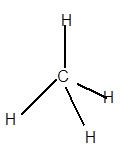
Interpretation:
The tetrahedron shape of CH4 molecule and the similarities with NH3 and H2O needs to be explained.
Concept introduction:
The Lewis structure of an organic compound represents the bonding of atoms with lone pairs (if any). It indicates the bonds with atoms and also the arrangement of atoms in a molecule.
Hybridization of an atom indicates the molecular geometry of a molecule. The formula to check the hybridization can be written as:
Hybridization = Number of sigma bonds + Number of lone pair
The molecular geometry of molecules with lone pair on central atom is given by the VSEPR theory.
Answer to Problem 9E
All these three molecules have the same type of hybridization and should have tetrahedral geometry but due to the presence of lone pairs on the central atom, the molecular geometry changes to a pyramidal and bent shape.



Explanation of Solution
For Lewis structure of CH4 molecule, calculate total number of valence electrons:
CH4 molecule = 4 electrons in C + 4 × 1 valence electrons in H = 8 electrons

Hybridization = Number of sigma bonds + Number of lone pair
Hybridization of C atom = 4 + 0 = 4 = sp3
Thus, with sp3 hybridization, the molecular shape must be tetrahedral and must be fit in a tetrahedron.
For Lewis structure of NH3 molecule, calculate total number of valence electrons:
NH3 molecule = 5 electrons in N + 3 × 1 valence electrons in H = 8 electrons

Hybridization = Number of sigma bonds + Number of lone pair
Hybridization of N atom = 3 + 1 = 4 = sp3
Thus, with sp3 hybridization, the molecular shape must be tetrahedral but due to the presence of lone pair on the central N atom, the geometry alters to trigonal pyramidal shape.
For Lewis structure of H2O molecule, calculate total number of valence electrons:
H2O molecule = 6 electrons in O + 1 × 2 valence electrons in H = 8 electrons

Hybridization = Number of sigma bonds + Number of lone pair
Hybridization of O atom = 2 + 2 = 4 = sp3
Thus, with sp3 hybridization, the molecular shape must be tetrahedral but due to the presence of two lone pairs on the central O atom, the geometry alters to a bent shape.
Although all these three molecules have same type of hybridization and should have tetrahedral geometry but due to presence of lone pairs on central atom, the molecular geometry changes to pyramidal and bent shape.
Chapter U2 Solutions
Living by Chemistry
Additional Science Textbook Solutions
Chemistry: Structure and Properties (2nd Edition)
Essential Organic Chemistry (3rd Edition)
Introductory Chemistry (5th Edition) (Standalone Book)
Introductory Chemistry (6th Edition)
Chemistry: The Central Science (13th Edition)
Chemistry: The Central Science (14th Edition)
 ChemistryChemistryISBN:9781305957404Author:Steven S. Zumdahl, Susan A. Zumdahl, Donald J. DeCostePublisher:Cengage Learning
ChemistryChemistryISBN:9781305957404Author:Steven S. Zumdahl, Susan A. Zumdahl, Donald J. DeCostePublisher:Cengage Learning ChemistryChemistryISBN:9781259911156Author:Raymond Chang Dr., Jason Overby ProfessorPublisher:McGraw-Hill Education
ChemistryChemistryISBN:9781259911156Author:Raymond Chang Dr., Jason Overby ProfessorPublisher:McGraw-Hill Education Principles of Instrumental AnalysisChemistryISBN:9781305577213Author:Douglas A. Skoog, F. James Holler, Stanley R. CrouchPublisher:Cengage Learning
Principles of Instrumental AnalysisChemistryISBN:9781305577213Author:Douglas A. Skoog, F. James Holler, Stanley R. CrouchPublisher:Cengage Learning Organic ChemistryChemistryISBN:9780078021558Author:Janice Gorzynski Smith Dr.Publisher:McGraw-Hill Education
Organic ChemistryChemistryISBN:9780078021558Author:Janice Gorzynski Smith Dr.Publisher:McGraw-Hill Education Chemistry: Principles and ReactionsChemistryISBN:9781305079373Author:William L. Masterton, Cecile N. HurleyPublisher:Cengage Learning
Chemistry: Principles and ReactionsChemistryISBN:9781305079373Author:William L. Masterton, Cecile N. HurleyPublisher:Cengage Learning Elementary Principles of Chemical Processes, Bind...ChemistryISBN:9781118431221Author:Richard M. Felder, Ronald W. Rousseau, Lisa G. BullardPublisher:WILEY
Elementary Principles of Chemical Processes, Bind...ChemistryISBN:9781118431221Author:Richard M. Felder, Ronald W. Rousseau, Lisa G. BullardPublisher:WILEY





